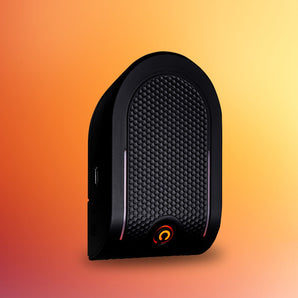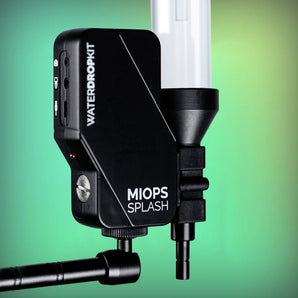Attaching the MIOPS Smart Camera Trigger to your flash gives you the ability to trigger your flash unit using many different creative options. Whether you want the flash to fire when it hears a noise or when an object trips the laser, you suddenly have pinpoint precision on timing in order to nail that perfect shot.
Sometimes you may find yourself needing a little bit more “oomph” than you get from a single flash unit. Bringing in a second flash unit to give a burst of light from a different angle can be the difference maker that you need in order to produce that exceptional picture you were looking for.
Fortunately, external flash units come with a ready-made option for firing without requiring any additional wires or cables: Slave Mode.

Two flashes, one tinted blue and one tinted red, work together to add a surreal flavor to this image.
In this article, you will learn some useful tips about triggering multiple flashes with Slave Mode using MIOPS Smart Camera Trigger.
How does Slave Mode work?
Slave Mode is a very useful feature that enables a flash to trigger instantly when the sensor on the front of the unit registers light from another flash. By using Slave Mode you can set up as many extra flash units as you’d like that will all effectively trigger at the exact same time.
For a practical example, this means that we can rig our MIOPS Smart trigger to our primary flash unit, then set it up to trigger right when our model car splashes into the water.
Make sure you select slave mode on the flash in order to have it trigger when it sees a burst of light. You may need to check the manual for your specific flash unit in order to learn how to do this.

Our first flash fires…

…and the second responds immediately once it registers the burst of light.
If you are ever having trouble with getting the slave mode to fire, make sure that the infrared sensor on the front of the flash is positioned so that it can “see” the light from your primary flash. Remember that you will need to manually set the power for your slave flash unit as well.
Why should I use more than one flash?
When shooting high-speed photography, the only light in the image will be the light coming from your flash unit. Your camera settings should prevent any ambient light from getting into the shot, which would create ghosting or color shift.

MIOPS SMART+
Take impossible photos by turning your camera into a high-speed capture device!
Using only one flash can cause deep shadows, depending on the how the flash is positioned and whether or not there are any modifiers such as an umbrella or softbox. While this single-light style can be used for creative effect, there are times when you may want to include more light into the scene.
Bringing in a second flash can help fill shadows. Be aware that when using multiple lights, you should always make sure that your key light is stronger than your fill lights – otherwise you get flat, shadowless lighting that robs the texture and dimension from the shot.

This portrait of some chess pieces taken with one light has a cool blue tone…

…and bringing in a second flash in slave mode quickly creates an interesting contrast.
Another reason you may consider using more than one flash is for a burst of color. Attaching a color gel to your secondary flashes can add interest by creating a rim of colored light around your subject or using contrasting tones to add a surreal feel to the shot.
Things to keep in mind
Note that when using off-camera flash, the power output for all flash units must be set manually – it can’t rely on information from the camera to automatically understand how much power to use.
It may take some time to become familiar with how ISO, aperture, flash power and distance to the subject can be balanced to order to get the exact output of light you are looking for. However, nailing that perfectly lit image is a great reward so stick at it until you’ve mastered the skill!
About the Author
Frank Myrland is a freelance photographer who specializes in using creative, off-camera lighting to make dramatic images. He is a regular contributor to the popular photography blog Digital Photography School. You can see some of his work at frankmyrland.com or follow him on Instagram at www.instagram.com/frankmyrlandphoto.
Related Article: High Speed Photography Explore Site












